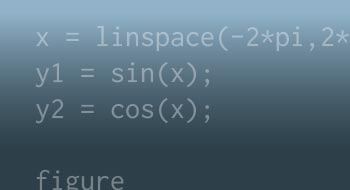Working with Arrays of Structures
Though I have covered this topic somewhat in the past, it seems like a good time to refresh the information. There are recent posts on the MATLAB newsgroup relating to this topic such asthis one.
Contents
Original Question
Suppose I have a structure array and want to find all the entries with a value of 4,without looping, something like[m,n] = find(f.h == 4).
f(1).h = [1 2 3 4]; f(2).h = [5 6 7 8];try[m,n] = find(f.h == 4);end
Why can't I use thefindstatement directly? Let's take a look at the error message to understand.
lerr = lasterror; disp(lerr.message)
Error using ==> eq Too many input arguments.
Too many input arguments? Whatisf.h? For that matter, what exactly isfagain?
f
f = 1x2 struct array with fields: h
fis astructarray, andf.his a comma-separated list.
f.h
ans = 1 2 3 4 ans = 5 6 7 8
Alternatives
To turn this list into a MATLAB construct I can use, I'd normally either wrap it inside[]or{}. If I wrapf.hinside[], I lose the information about what is in the first element offand what is in the second.
[f.h]
ans = 1 2 3 4 5 6 7 8
Wrappingf.hinside{}, I have a cell array to work with.
{f.h}
ans = [1x4 double] [1x4 double]
I still can't immediately usefindor numeric functions on this array.
try[m,n] = find({f.h} == 4);endlerr = lasterror; disp(lerr.message)
Error using ==> evalin Undefined function or method 'eq' for input arguments of type 'cell'.
Solution
What I'd like is a way to work with my struct, without writing too much code, without looping, that is ideally a pattern I can reuse as my problem evolves. This is exactly whatarrayfunwas designed to help with. It works on each element of an array, and I need to just tell it what I want to operate on one element, as well as tellingarrayfunwhat array to work on.
Let's first find the values in the struct arrayfequal to 4. Since I have 2 arrays embedded inf, and they may each have different numbers of outputs, I have to clearly state that the outputs need to go into a cell array.
[m,n] = arrayfun(@(x)find(x.h==4),f,'uniformoutput',false)
m = [1] [1x0 double] n = [4] [1x0 double]
This becomes even more obvious if I can another array,gthat is even less "regular" thanf.
g = f; g(3).h = [1 2 17 4]; g(4).h = [1 3 17 5 9 17]; [mg,ng] = arrayfun(@(x)find(x.h==17),g,'uniformoutput',false)
mg = [1x0 double] [1x0 double] [1] [1x2 double] ng = [1x0 double] [1x0 double] [3] [1x2 double]
Some problems are more benign however and it would be wasteful to return results in a cell array and then have to unpack them into a numeric array, for example, the functionmax, which generally has a single value as the result.
[minval,idx] = arrayfun(@(x)max(x.h),f) [minval,idx] = arrayfun(@(x)max(x.h),g)
minval = 4 8 idx = 4 4 minval = 4 8 17 17 idx = 4 4 3 3
Related Topics
Here are some links to related blogs and MATLAB reference pages.
Your Thoughts
- Do you use struct arrays?
- If yes, do you usearrayfun, or do you use loops? Whichever your choice is, can you say more about why it's your choice?
- Do you avoid struct arrays all together and use something else? If so, what data representations do you use instead?
Let's see your feedbackhere.
- Category:
- Structures














 Cleve’s Corner: Cleve Moler on Mathematics and Computing
Cleve’s Corner: Cleve Moler on Mathematics and Computing Loren on the Art of MATLAB
Loren on the Art of MATLAB Steve on Image Processing with MATLAB
Steve on Image Processing with MATLAB Guy on Simulink
Guy on Simulink Deep Learning
Deep Learning Developer Zone
Developer Zone Stuart’s MATLAB Videos
Stuart’s MATLAB Videos Behind the Headlines
Behind the Headlines File Exchange Pick of the Week
File Exchange Pick of the Week Hans on IoT
Hans on IoT Student Lounge
Student Lounge Startups, Accelerators, & Entrepreneurs
Startups, Accelerators, & Entrepreneurs MATLAB Community
MATLAB Community MATLAB ユーザーコミュニティー
MATLAB ユーザーコミュニティー




Comments
To leave a comment, please clickhereto sign in to your MathWorks Account or create a new one.